Hager EUM200 Handleiding
Hager
Niet gecategoriseerd
EUM200
Bekijk gratis de handleiding van Hager EUM200 (6 pagina’s), behorend tot de categorie Niet gecategoriseerd. Deze gids werd als nuttig beoordeeld door 33 mensen en kreeg gemiddeld 4.5 sterren uit 17 reviews. Heb je een vraag over Hager EUM200 of wil je andere gebruikers van dit product iets vragen? Stel een vraag
Pagina 1/6

0101
6LE009155A
e
z
a
u
EUM200
Kontrollrelais Spannung, Phasenüberwa-
chung, einstellbar 1P+N/3P(N) 2 Wechsler
Voltage and phase control relay 1P+N/3P(N)
2 Change over contacts
Relais de contrôle tension et phase
1P+N/3P(N) 2 contact inverseurs
Επιτηρητής τάσης και φάσεων, ρυθμιζόμε-
νος 1P+N/3P(N) 2 μεταγωγικές επαφές
EUM200
Voltage and phase control relay 1P+N/3P(N)
01
fällt das Ausgangsrelais R ab (gelbe LED leuchtet
nicht). Das Ausgangsrelais zieht wieder an (gelbe
LED leuchtet), wenn die gemessene Spannung wie-
der unter den Maximumwert absinkt (rote LED Max
leuchtet nicht). Sinkt die gemessene Spannung (eine
der Phasenspannungen) unter den am Min-Regler
eingestellten Wert, beginnt die eingestellte Auslösever-
zögerung abzulaufen (rote LED Min blinkt). Nach Ablauf
der Verzögerungszeit (rote LED Min leuchtet), fällt das
Ausgangsrelais R ab (gelbe LED leuchtet nicht).
Bild 5: Windowfunktion (W)
− (Seq)Überwachung Phasenfolge
Bei allen Funktionen ist die Überwachung der Pha-
senfolge zuschaltbar. Bei einer Änderung der Pha-
sendrehrichtung (rote LED Seq leuchtet) fällt nach
Ablauf der Auslöseverzögerung das Ausgangsre-
lais R ab (gelbe LED leuchtet nicht).
Hinweis
Bei einphasigen Stromkreisen muss die
Phasenfolgeüberwachung abgeschaltet
werden.
LED Seq
L1
L2
L3
U
Delay
Bild 6: Überwachung Phasenfolge (Seq)
− Überwachung Phasenausfall
Das Ausgangsrelais R fällt ab (gelbe LED leuchtet
nicht), wenn eine der Phasen ausfällt.
U
L1
L2
L3
Bild 7: Überwachung Phasenausfall
− Überwachung Asymmetrie
Das Ausgangsrelais R fällt ab (gelbe LED leuchtet
nicht), wenn die Asymmetrie den am ASYM-Regler
eingestellten Wert überschreitet.Die Abschaltung
erfolgt auch dann, wenn die Asymmetrie aufgrund
von Rückspannungen von auf 2 Phasen laufenden
Motoren verursacht wird.
U
L1
L2
L3
Bild 8: Überwachung Asymmetrie
e Sicherheitshinweise
Einbau und Montage elektrischer Geräte dür-
fen nur durch eine Elektrofachkraft gemäß den
einschlägigen Installationsnormen, Richtlinien,
Vorschriften, Bestimmungen und Unfallverhü-
tungsvorschriften des Landes erfolgen.
Bei Nichtbeachten der Installationshinweise
können Schäden am Gerät, Brand oder andere
Gefahren entstehen.
Geräteaufbau
1 Einstellbare Auslöseverzögerung
2 Maximaler Schwellenwert (% von UN)
3 Einstellbare Asymmetrie
4 Minimaler Schwellenwert (% von UN)
5 Funktionsauswahl
6 Sequenzfehleranzeige (rot)
7 Kontrollleuchte MAX (rot)
8 Kontrollleuchte MIN (rot)
9 Statusanzeige des Ausgangsrelais R (gelb)
Funktion
Spannungsüberwachung in 3- und 1-Phasen-
netzen mit einstellbaren Schwellwerten, einstell-
barer Auslöseverzögerung, Überwachung von
Phasenausfall, Phasenfolge und Asymmetrie mit
einstellbarer Asymmetrie. Die Funktionen und
Schwellenwerte werden mit den 5 Potentiometern
eingestellt. Die 4 Kontrollleuchten geben Auskunft
über den Status des Geräts und der Installation.
Bestimmungsgemäßer Gebrauch
− Spannungsüberwachung in 1/3-Phasennetzen
zur Unterspannungs- und Spannungsbe-
reichsüberwachung
− Überwachung von Phasenfolge, Phasenausfall
und Asymmetrie
− -Montage auf Hutschiene nach TH 35 7,5-15 ge
mäß IEC 60715:2017 / EN 60715:2017
Funktionsbeschreibung
− (U)Unterspannungsüberwachung
Wenn die gemessene Spannung (eine der Phasen-
spannungen) unter den am Min-Regler eingestellten
Wert sinkt, beginnt die eingestellte Auslöseverzöge-
rung abzulaufen (rote LED Min blinkt). Nach Ablauf
der Verzögerungszeit (rote LED Min leuchtet), fällt das
Ausgangsrelais R ab (gelbe LED leuchtet nicht). Über-
schreitet die gemessene Spannung (alle Phasenspan-
nungen) den am Max-Regler eingestellten Wert, zieht
das Ausgangsrelais R wieder an (gelbe LED leuchtet).
Bild 4: Unterspannungsüberwachung (U)
− (W)Windowfunktion
Das Ausgangsrelais R zieht an (gelbe LED leuchtet),
wenn die gemessene Spannung (alle Phasenspan-
nungen) den am Min-Regler eingestellten Wert über-
schreitet. Wenn die gemessene Spannung (eine der
Phasenspannungen) den am Max-Regler eingestellten
Wert überschreitet, beginnt die eingestellte Auslöse-
verzögerung abzulaufen (rote LED Max blinkt). Nach
Ablauf der Verzögerungszeit (rote LED Max leuchtet),
N L1
15
16 18
R
16 15
L1
N
1~
L2 L3
25
26 28
R
18 28
26 25
N L1
15
16 18
R
16 15
L1
L2
L3
N
3N~
L2 L3
25
26 28
R
18 28
26 25
1
2
3
4
5
6
7
8
9
02
03

02
Informationen für die Elektro-
fachkraft
Montage und elektrischer
Anschluss
GEFAHR!
Elektrischer Schlag bei Berühren
spannungsführender Teile!
Elektrischer Schlag kann zum
Tod führen!
•Vor Arbeiten am Gerät An-
schlussleitungen freischalten
und spannungsführende Teile
in der Umgebung abdecken!
•Das Gerät auf der Hutschiene fixieren.
•Das Gerät gemäß Bild 2/3 anschließen und
verdrahten.
Anhang
Technische Daten
Allgemein
Versorgungsspannung..................3(N)~400/230 V
Nennverbrauch 11 VA (1,2 W) ................................
Nennfrequenz AC 50 ... 60 Hz ...............................
Wiederbereitschaftszeit 500 ms .............................
Abfallspannung ......................................................
......................>20% der Versorgungsspannung
Ausgangskreis (2 potenzialfreie Wechsler)
Bemessungsspannung 250 V ................................
Schaltleistung 1250VA (5A / 250V a.c.) ..................
Absicherung 5 A ....................................................
Lebensdauer
− mechanisch 20 x 10 ..................... 6 Schaltspiele
− elektrisch 2 x 10 ........................... 5 Schaltspiele
............................... bei 1000VA ohmscher Last
Schalthäufigkeit .....................................................
.............max. 6/min bei 1000VA ohmscher Last
Überspannungskategorie III (nach IEC 60664-1) ...
Bemessungsstoßspannung 4 kV ............................
Isolationsspannung 480 V (IEC 60947-5-1) ...........
Isolationsprüfspannung 1800 V (IEC 60947-5-1) ...
Anschlussklemmen Querschnitte
− mit Aderendhülse ...............................................
.............1 x 0.5 ... 2.5 mm² / 2 x 0.5 ... 1.5 mm²
− ohne Aderendhülse ............................................
.....................................1 x 4 mm² / 2x 2.5 mm²
Messkreis
− Messgröße 3(N)~, sinus, 48 ... 63 Hz .................
− Messeingang 3(N)~400/230 V ............................
− Überlastbarkeit bestimmt durch die für die .......
Versorgungsspannung angegebene Toleranz
Schaltschwelle US
− Max 80%...130% von U ................................... N
− Min 70%...120% von U .................................... N
− Asymmetrie 5%... 25% von U .......................... N
− , OFF
Abmessungen (BxHxT) 35 x 87 x 65 mm ...............
...............................................(nach DIN 43880)
Genauigkeit
− Grundgenauigkeit ≤5% vom Nennwert .............
− Wiederholgenauigkeit ≤2% vom Nennwert .......
− Temperatureinfluss ≤0,05% /°C .........................
Temperatur
− Umgebung -25 bis +55 °C .................................
− Lager/Transport -25 bis +70 °C .........................
− Relative Luftfeuchtigkeit 15% bis 85% ..............
..................... (nach IEC 60721-3-3 Klasse 3K3)
− Verschmutzungsgrad 2 (nach IEC 60664-1) .......
Klemmen/Anschlüsse Schutzart IP20 ..................
− Neutralleiterbruch
Das Gerät überwacht jede Phase (L1, L2 und L3)
gegen N. Durch eine unsymmetrische Phasenlast
kommt es bei Neutralleiterbruch in der Netzleitung
zu einer Verschiebung des Sternpunktes. Wenn eine
der Phasenspannungen die eingestellte Abschalt-
schwelle (Min oder Max) überschreitet, beginnt die
Auslöseverzögerung abzulaufen (rote LED Min oder
Max blinkt). Nach Ablauf der Verzögerungszeit (rote
LED Min oder Max leuchtet) fällt das Ausgangsrelais
R ab (gelbe LED leuchtet nicht).
Bild 9: Neutralleiterbruch
LED-ANZEIGE Bedeutung
LED Seq (6) Indikator für Phasenfolgefehler
Rote LED an Anzeichen einer Störung (eine Änderung
der Phasenfolge wird erkannt)
Rote LED
blinkt
Anzeige eines Fehlers innerhalb der
eingestellten Auslöseverzögerung
(eine Änderung der Phasenfolge
wird innerhalb der eingestellten
Auslöseverzögerung erkannt)
LED aus Keine Änderung der Phasenfolge
LED Max (7) Maximalwert Ausfallanzeige
Rote LED an Ausfallanzeige (Messwert liegt über
dem Max-Schwellenwert)
Rote LED
blinkt
Anzeige eines Fehlers innerhalb der
eingestellten Auslöseverzögerung
(Messwert liegt über dem Max-
Schwellenwert und innerhalb der
eingestellten Auslöseverzögerung)
LED aus Der aktuelle Wert liegt innerhalb des
eingestellten Bereichs
LED Min (8) Minimalwert Ausfallanzeige
Rote LED an Ausfallanzeige (Messwert liegt unter
dem Min-Schwellenwert)
Rote LED
blinkt
Anzeige eines Fehlers innerhalb der
eingestellten Auslöseverzögerung
(Messwert liegt unter dem Min-
Schwellenwert und innerhalb der
eingestellten Auslöseverzögerung)
LED aus Der aktuelle Wert liegt innerhalb der
eingestellten Schwelle
LED R (9) Versorgungsspannung und
Stellung des Ausgangsrelais R
Gelbe LED an Ausgangsrelais R ist angezogen und
in Ausgangsstellung
LED aus Ausgangsrelais R ist in aktiver Stellung
Hinweis
Bei allen Funktionen blinken die LED's
Min und Max abwechselnd (das Relais
ist abgefallen), wenn der Minimalwert
für die gemessene Spannung größer
als der Maximalwert gewählt wurde.
Liegt bei der Aktivierung des Geräts be-
reits ein Fehler vor, bleibt das Ausgangs-
relais in Ausgangsstellung und die LED
für die entsprechende Schwelle leuchtet.
z Safety instructions
Electrical equipment must only be installed and
assembled by a qualified electrician in accor-
dance with the relevant installation standards,
regulations, directives and safety and accident
prevention directives of the country.
Failure to comply with these installation instruc-
tions may result in damage to the device, fire or
other hazards.
Design and layout of the device
1 Adjusable tripping delay
2 Maximum threshold value (% of U
N)
3 Adjustable asymmetry
4 Minimum threshold value (% of U
N)
5 Function selection
6 Sequence failure indicator (red)
7 MAX indicator lamp (red)
8 MIN indicator lamp (red)
9 Output relay status indicator R (yellow)
Function
Voltage monitoring in 3-phase and 1-phase mains
with adjustable thresholds, adjustable tripping delay,
monitoring of phase sequence, phase failure and
asymmetry. The functions and threshold values are
set with the 5 potentiometers. The 4 indicator lamps
provide information on the status of the device.
Correct use
− Voltage monitoring in 1/3-phase networks for
undervoltage and voltage range monitoring
− Monitoring of phase sequence, phase failure
and asymmetry
− Mounting on DIN rail after TH 35 7.5-15 ac-
cording to IEC 60715:2017 / EN 60715:2017
Functional description
− (U)Undervoltage monitoring
When the measured voltage (one of the phase
voltages) falls below the value adjusted at the
Min-regulator, the set interval of the tripping delay
begins (red LED Min flashes). After the interval has
expired (red LED Min illuminated), the output relay
R switches into active position (yellow LED not
illuminated). The output relay R switches into initial
position again (yellow LED illuminated), when the
measured voltage (all phase voltages) exceeds the
value adjusted at the Max-regulator.
Figure 4: Undervoltage monitoring (U)
− (W)Windowfunction
The output relay R switches into initial position (yel-
low LED illuminated), when the measured voltage
(all phase voltages) exceeds the value adjusted at
the Min-regulator. When the measured voltage (one
of the phase voltages) exceeds the value adjusted
at the Max-regulator, the set interval of tripping
delay begins (red LED Max flashes). After the
interval has expired (red LED Max illuminated) the
output relay R switches into active position (yellow
LED not illuminated). The output relay switches
into initial position again (yellow LED illuminated)
when the measured voltage falls below the value
Verschiebung des
Sternpunktes

03 Hager Electro SAS-BP3-67215 Obernai Cedex, France
Information for electricians
Installation and electrical con-
nection
DANGER!
Electrical shock when live parts
are touched!
An electric shock can lead to
death!
•Isolate all power before working
on the device and cover any
live parts in the area!
•Fix the device on the DIN rail.
•Connect and wire the device according to
Figure 2/3
Appendix
Technical data
Supply voltage 3(N)~400/230 V ..............................
Rated consumption 11 VA (1,2W) ..........................
Rated frequency AC 50 ... 60 Hz ...........................
Recovery time 500 ms ...........................................
Drop out voltage ....................................................
.............................. >20% of the voltage supply
Output circuit
(2 potential-free change-over contacts)
Rated voltage 250 V ..............................................
Switching capacity 1250VA (5 A / 250 V a.c.) ........
Fuse protection 5 A fast acting ..............................
Service life
− Mechanical 20 x 10 ............................... 6 Cycles
− Electrical 2 x 10 ..................................... 5 Cycles
.................................... at 1000VA resistive load
Switching capacity ................................................
................. max. 6/min at 1000VA resistive load
Overvoltage category III (nach IEC 60664-1) .........
Rated surge voltage .......................................4 kV
Insulation voltage 480 V (IEC 60947-5-1) ..............
Insulation testing voltage 1800 V (IEC 60947-5-1) .
Connecting terminal cross-sections
− with conductor sleeve .......................................
.............1 x 0.5 ... 2.5 mm² / 2 x 0.5 ... 1.5 mm²
− without conductor sleeve ..................................
.....................................1 x 4 mm² / 2x 2.5 mm²
Measuring circuit
− Measurement variable .......................................
.................................. 3(N)~, sinus, 48 ... 63 Hz
− Measurement input 3(N)~400/230 V ...................
− Overload capability .....determined by tolerance
.............................. specified for supply voltage
Switching threshold US
− Max 80%...130% of U ...................................... N
− Min 70%...120% of U ....................................... N
− Asymmetrie 5%... 25% of U .................... N, OFF
Dimensions 35 x 87 x 65 mm .................................
Genauigkeit
− Basic accuracy ≤5% of nominal value ...............
− Repeat accuracy ≤2% ........................................
− Temperature influence ≤0,05% /°C ....................
Temperature
− Environment -25 ... +55°C ..................................
− Warehouse/transport -25 ... +70°C ....................
− Relative humidity 15% ... 85% ..........................
...........(according to IEC 60721-3-3 Class 3K3)
− Pollution degree 2 (according to IEC 60664-1) ..
Degree of protection IP20 ......................................
adjusted at the Max-regulator (red LED Max not
illuminated). When the measured voltage (one of
the phase voltage) falls below the value adjusted
at the Min-regulator, the set interval of tripping
delay begins again (red LED Min flashes). After the
interval has expired (red LED Min illuminated), the
output relay R switches into active positon (yellow
LED not illuminated).
Figure 5: Windowfunction (W)
− (Seq)Phase sequence monitoring
Phase sequence monitoring is selectable for
all functions. In single phase circuit, the phase
sequence monitoring must be disconnected. If a
change in phase sequence is detected (red LED
Seq illuminated), the output relay R switches into
active position after the set interval of tripping delay
has expired (yellow LED not illuminated).
Notice
For single-phase circuits, the phase
sequence monitoring must be switched
off.
LED Seq
L1
L2
L3
U
Delay
Figure 6: Phase sequence monitoring (Seq)
− Phase failure monitoring
The output relay R switches into active position
(yellow LED not illuminated), when one of the three
phases fails.
U
L1
L2
L3
Figure 7: Phase failure monitoring
− Asymmetry monitoring
The output relay R switches into an active position
(yellow LED not illuminated) when the asymmetry
exceeds the value set at the ASYM-regulator.
Reverse voltages of a consumer (e.g. a motor
which continues to run on two phases only) do not
effect the disconnection.
U
L1
L2
L3
Figure 8: Asymmetry monitoring
− Neutral wire break
The device monitors every phase (L1, L2 and L3)
against the neutral wire N. A shift of neutral point
occurs by an asymmetrical phase load if the neutral
wire breaks in the power line. If one of the phase volt-
ages exceeds the value adjusted at the trip point, the
set interval of tripping delay begins (red LED Min or
Max flashes). After the interval has expired (red LED
Min or Max illuminated), the output relay switches into
active position (yellow LED not illuminated).
Figure 9: Neutral wire break
LED DISPLAY Meaning
LED Seq (5) Phase sequence failure indicator
Red LED on Indication of failure (a change in phase
sequence detected)
Red LED
flashing
Indication of failure within the set tripping
delay (a change in the phase sequence is
detected within the adjusted tripping delay)
Red LED off No change in the phase sequence
detected
LED Max (6) Max-value failure indicator
Red LED on Indication of failure (measured value is
beyond the max-threshold)
Red LED
flashing
Indication of failure within the set
tripping delay (measured value is
beyond the max-threshold value and
within the adjusted tripping delay)
Red LED off The measured value is below the max-
threshold
LED Min (7) Min-value failure indicator
Red LED on Indication of failure (measured value is
below the min-threshold)
Red LED
flashing Indication of failure within the set
tripping delay (measured value is below
the min-threshold value and within the
adjusted tripping delay)
Red LED off The measured value is beyond the
min-threshold
LED R (8) Supply voltage and output relay R
position
Yellow LED
on
Output relay R is energized and is in the
initial position
Yellow LED
off
Output relay R is in the active position
Notice
For all functions the LED‘s Min and
Max are flashing alternating (the relay is
fallen off), when the minimum value for
the measured voltage was chosen to
be greater than the maximum value.
If there is already an error when the
device is activated, the output relay
remains in initial position and the LED
for the corresponding threshold is
illuminated.
Shift of neutral
point
Product specificaties
| Merk: | Hager |
| Categorie: | Niet gecategoriseerd |
| Model: | EUM200 |
Heb je hulp nodig?
Als je hulp nodig hebt met Hager EUM200 stel dan hieronder een vraag en andere gebruikers zullen je antwoorden
Handleiding Niet gecategoriseerd Hager
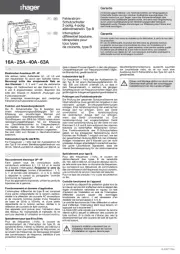
12 Mei 2025
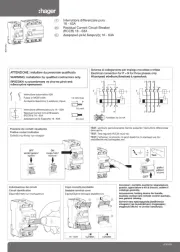
12 Mei 2025

12 Mei 2025
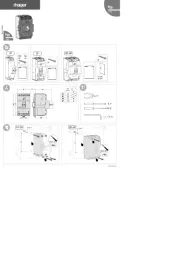
12 Mei 2025
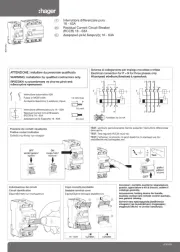
12 Mei 2025
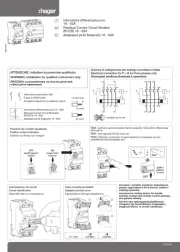
12 Mei 2025
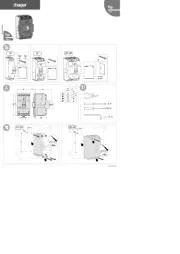
12 Mei 2025
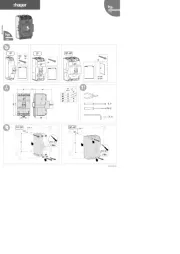
12 Mei 2025
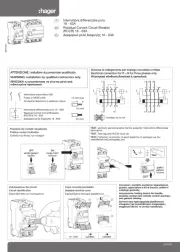
12 Mei 2025
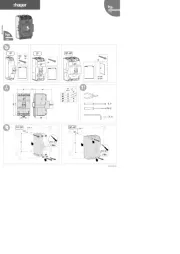
12 Mei 2025
Handleiding Niet gecategoriseerd
- Oreck
- SpeakerCraft
- Speakman
- Parisot
- Chieftec
- Neno
- Graphite
- Prenatal
- Meireles
- Fersgo
- Speaker Snap
- Lectrosonics
- FBT
- Fluidmaster
- Lorelli
Nieuwste handleidingen voor Niet gecategoriseerd

17 September 2025

17 September 2025

17 September 2025

17 September 2025

17 September 2025
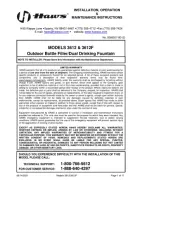
17 September 2025

17 September 2025

17 September 2025
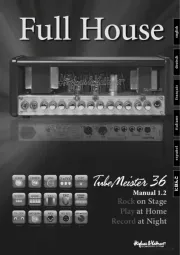
17 September 2025

17 September 2025